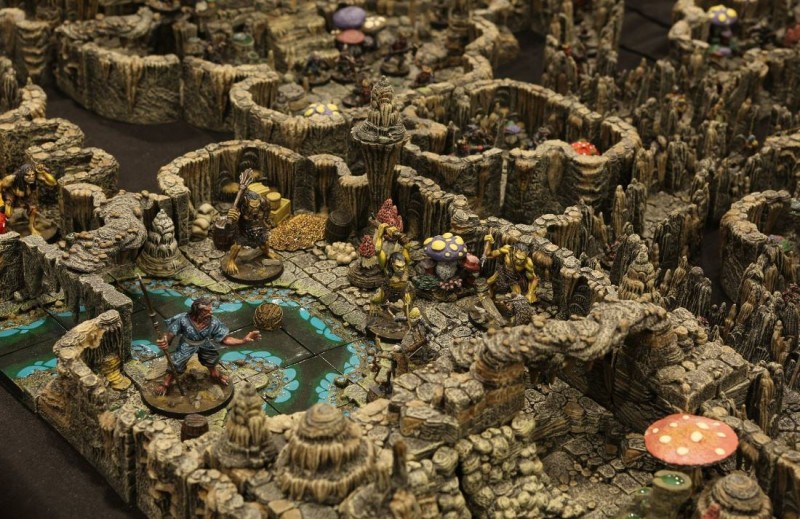
Introduction
In the world of art and craftsmanship, miniature dioramas hold a special place. These meticulously crafted scenes capture moments in time, allowing us to explore and appreciate their historical context. Miniature dioramas are not only visually appealing but also serve as valuable educational tools, offering a glimpse into the past. In this article, we will delve into the art of creating miniature dioramas, exploring their historical significance and the techniques used to bring these tiny worlds to life.
1. The History of Miniature Dioramas
Miniature dioramas have a rich history that dates back centuries. They were initially used by architects and military strategists to visualize and plan buildings and battle tactics. In the 19th century, dioramas gained popularity as a form of entertainment, often depicting historical events or exotic landscapes. Over time, artists began creating miniature dioramas as standalone works of art, capturing various scenes from everyday life or significant moments in history.
2. Materials and Tools Required
To create a miniature diorama, you will need a range of materials and tools. Some essential supplies include:
Modeling clay or foam for the base and landscape
Various paints and brushes
Cutting tools for shaping and detailing
Glues and adhesives for securing components
Miniature figurines and accessories
Lighting elements for added realism
Reference materials for accuracy
3. Planning the Diorama: Choosing a Theme
Before embarking on your diorama project, it is crucial to choose a theme or concept. You could recreate a historical battle, a bustling city street from a specific era, or a serene natural landscape. Consider your interests and the historical context you wish to explore.
4. Gathering Reference Materials
To ensure accuracy and authenticity, gather reference materials related to your chosen theme. Books, photographs, and online resources can provide valuable insights into the architecture, clothing, and overall ambiance of the time period you are depicting.
5. Scale and Proportions
Decide on the scale and proportions of your diorama. This determines the size of your figures, buildings, and other elements. Common scales include 1:12, 1:24, and 1:48. Ensure that the proportions are accurate to maintain realism.
6. Constructing the Base and Landscape
Begin by constructing the base of your diorama using modeling clay or foam. Sculpt and shape it to create a natural-looking landscape. Consider adding contours, hills, or even water features to enhance the visual appeal.
7. Adding Buildings and Structures
Integrate buildings and structures into your diorama, reflecting the architectural styles of the chosen time period. Use reference materials to guide your design choices and pay attention to details such as windows, doors, and textures.
8. Detailing the Scene: Vegetation and Accessories
Incorporate vegetation, such as trees, bushes, and flowers, into your diorama to bring it to life. Additionally, add small accessories like street signs, furniture, or vehicles to enhance the realism and add depth to the scene.
9. Painting Techniques for Realism
Painting is a crucial step in creating a realistic diorama. Use techniques such as dry brushing, washes, and blending to add depth, texture, and realistic colors to your structures, figures, and landscape.
10. Lighting and Atmosphere
Consider the lighting and atmosphere of your diorama. You can use LED lights or natural lighting to create specific moods, emphasizing shadows and highlighting focal points. Experiment with different lighting setups to achieve the desired effect.
11. Preserving and Displaying Miniature Dioramas
Once your diorama is complete, it is essential to preserve and protect it. Consider using a display case to shield it from dust and damage. Regular cleaning and maintenance will ensure its longevity.
12. Exploring the Educational Value
Miniature dioramas offer a unique educational experience. They allow viewers to step back in time and visualize historical events or environments. Museums often utilize dioramas to educate visitors about various subjects, making learning interactive and engaging.
13. The Rise of Miniature Diorama Art
In recent years, miniature diorama art has gained significant recognition and popularity. Artists worldwide are pushing the boundaries of this medium, creating intricate and captivating scenes that captivate audiences. Their works are exhibited in galleries, art fairs, and online platforms, attracting both art enthusiasts and collectors.
14. Miniature Dioramas in Popular Culture
Miniature dioramas have also made their mark in popular culture. They are featured in movies, television shows, and video games, immersing audiences in visually stunning and realistic worlds. These depictions further inspire enthusiasts to explore the art of creating dioramas themselves.
15. Conclusion
Creating miniature dioramas is a captivating art form that allows us to appreciate history and exercise our creativity. Through careful planning, attention to detail, and artistic techniques, these miniature worlds come to life. Whether for personal enjoyment, educational purposes, or artistic expression, miniature dioramas continue to fascinate and inspire individuals of all ages.
BREAKING! Manipur violence, Mob sets two vehicles on fire
Rahul Gandhi Demonstrates Solidarity with Farmers by Riding a Tractor in Sonipat
Remembering the Legendary Dilip Kumar: A Tribute on His Death Anniversary